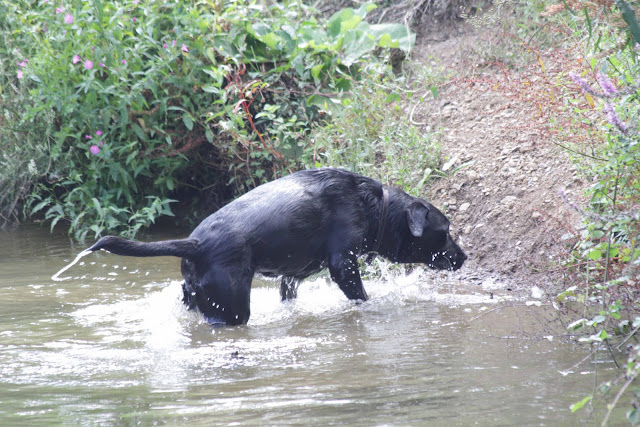No posting with photographs specifically from today I'm afraid, as I was on voluntary extra safety boat duty for the sailing club at Bewl.
However as well as visiting the wildlife pond behind the Elgar block yesterday I also took Monty up to Dene Park woods for a walk, so here are some more photographs from yesterday.
The Meadow Browns,
Maniola jurtina, had been forced off the grassy meadow by the car park (where they were laying eggs on the Yorkshire Fog grass,
Holcus lanata) after all the grass was cut last week by the maintenance crew, and had sought refuge in the nearby sections of the woodland paths and rides, at least able to get nectar from the hardheads,
Knautia arvensis. This one was in quite good condition and displayed its more colourful fore-wings well,
While this one was holding its fore-wings hidden behind its hind-wings and was very well camouflaged against the dead twigs and leaves on the ground, which it was testing with its tongue:
Since the paths have been cut back by an Allen cutter, there has been a little burst of flowering over the past few days at the junction in the rides from the common field speedwell,
Veronica persica:
Hover-flies were present in good numbers and diversity along the path, including the currently ubiquitous tiny narrow-bodied
Sphaerophoria scripta, which was resting up on some leaves low down by the side of the path, making a rather blurry photograph. This is a male:
A little further along the path, the hogweed flowers were attracting quite a range of hover-flies as usual, including this tiny
Meliscaeva cinctella, very similar to
Spaerophora scripta but with a clearly different pattern on the abdomen upperside, although the photo is again a bit blurry,
Sphaerophora and
Meliscaeva are both of a similar size and rather similar yellow and black pattern to some of the smaller true wasp species - the more
Sphaerophora and
Meliscaeva look like a wasp, the less likely they are to be attacked by birds, which are "once stung, twice shy" - Batesian mimicry. There are many more wasp species than people generally think, such as this beautiful one, much smaller than the familiar yellowjacket, also taking nectar from the ever-popular hogweed,
Heracleum sphondylium.
This is a much more difficult bover-fly to identify, very small and dark
and this is an
Eristalis species, probably
Eristalis pertinax, the one I think I generally see in Dene Park. This particular photo shows the face and the sides of the thorax particularly well. The face has a very thin central black line running down it, and it is also possible to see the plumose hairs on the side of the arista, the thin extension of the short antenna. The thorax is hairy, and overall the fly resembles a honey-bee, hopefully enough to deceive and put off most bird species that don't specialise in tackling such noxious insects as bees, with their foul-tasting venom. Specialist feeders such as flycatchers are less easily fooled by this mimicry.
I also saw one individual of the stunning solitary bee-mimic (more Batesian mimicry), the hover-fly
Criorhina floccosa which looks as though its an Elizabethan dandy all decorated with feathery ruffs.
This is a much larger hover-fly,
Volucella inanis, one of the biggest UK species, which is quite rare nationally, but rather common around London and in the surrounding counties. I've seen it in the hedgerows between Hadlow and East Peckham, and now also here:
This is a Small White butterfly,
Pieris rapae, a stronger flier than the Green Veined White, and generally more commonly found outside woods, but on this occasion nectaring from the knapweed flowers
Knautia arvensis commonly found along the sides of the rides:
And this is
Rhingia rostrata, a small "snouted" hoverfly species that is quite rare on a national scale (notable in the red data book). This is the second time, at least, I've seen it at Dene Park, although I've not seen it's much commoner close relative
Rhingia campestris at all yet!
The most common bumblebee seen here at the moment is the Common Carder Bee
Bombus pascuorum which is often seen on the knapweed flowers, which it can tackle with its longer face and tongue. This may well be a male "drone", as it doesn't seem to have pollen baskets on its rear legs :
This beautiful hover-fly below was new to me, and took me ages to get on the right track for its identification. Its pretty definitely in the genus
Melangyna (my first
Melangyna!) because of its black rear legs (except for the inside of the tibiae and tarsi which are lighter in this insect at least) coupled with the colour pattern on the abdomen upperside, the grey dusting on the sides of the thorax and the face pattern when viewed from the front. At the moment the species most likely to be in the frame is
Melangyna labiatarum, which is supposed to be a Southern species separated from the Northern
Melangyna compositarum, but these might actually just be variants of the same species.
The pictures on Google and the Hoverfly Recording Scheme confirm that this ID is likely, with a brown rather than shiny black thorax, light or golden and not black hairs on the thorax, pairs of generally oblong lemon yellow spots on the upperside of the abdomen, clearly all nearer the front of the tergites (the upper abdominal plates) with the front pair of spots extending to the sides with a narrower bridge and joining to the similarly coloured lemon yellow underside of the abdomen. As in most hover-fly genera, this is easily seen to be a female when viewed from the front, with its eyes well separated.
To finish off, this a fairly good picture of another
Sphaerophora scripta, in this case a female, showing the partial dark face stripe, and a different colour pattern on the abdomen upperside:


















































